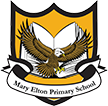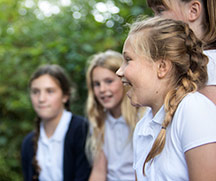Our School History
Our School
Our school was built in 1982. We are named after Mary Elton, a member of the Elton family of Clevedon Court. Mary was a Victorian benefactress who had a particular interest in the education of the children in Clevedon.
We educate children between the ages of 4 and 11. The total number of pupils is usually between 400 and 420. Each of our year groups has two parallel classes, with about 30 children in each.
Our school was originally built for 280 children, so we have grown significantly, with the Kikoboga building being completed in 2009 housing an additional six classrooms. We also have a School Library, opened in 1998, and a computer suite suitable for teaching a class of 30. We have a large School Hall.
The school has extensive grounds which provide excellent facilities for sport and environmental activities, as well as providing space for the children to take part in their own activities at supervised lunch and play times.
Mary Elton
Mary, Lady Elton (née Stewart) b1773 d1849
Mary Elton was the second wife of the fifth baronet, The Reverend Sir Abraham Elton (17551842). She was 50 years old when she married Sir Abraham in 1823, when he was 68. She was born in Castle Stewart (a place, not a castle), in Wigtonshire, Scotland. Her father was William Stewart and she had at least two sisters. Mary was well-educated and had ample leisure and talents to pursue her interests in landscape and sketching. A book of her sketches, 'Panoramic Views of Edinburgh' was published in 1822, and she made much use of her artistic talents were when she came to Clevedon to live.
Mary and Sir Abraham developed Clevedon as a seaside resort. They laid out walks and provided shaded seats in the two copses that later became the Pier Copse and Alexandra Gardens, subsequently given to the town by Sir Arthur Hallam Elton. They had steps cut in the rock from the Royal Hotel in Hill Road to Dial Hill, and created other walks, possibly including that from Norton’s Wood to Clapton. Names of localities such as 'Fir Woods', 'Bonnie View' and 'Mountain Pass' have fallen into disuse in recent years, but the associated footpaths remain on Court Hill and Strawberry Hill. The hillsides of Clevedon were imaginatively planted with shrubs and trees, and vistas were created for foot or road travellers through the village. Mary sketched these and numerous churches and buildings of note in the area, and had them engraved for lithographs. Many of these were included as prints in Clevedon guidebooks of the time (Chilcott’s guides, published from the mid-1840s).
Their friend, the antiquarian GW Braikenridge, encouraged Sir Abraham and Lady Elton to develop a mock baronial style at Clevedon Court, with panelling and carving such as the coats of arms of England’s kings and stags’ heads. Old stone and plaster work of former eras at the Court were painted chocolate brown to represent woodwork.
Her philanthropy was evident in the village. She had the first Parish School built in 1834 (near the present fire station). In 1838 she saw Christchurch built by Braikenridge with the support of Sir Abraham. In 1846 she had the Infant School built (now Clevedon Town Council offices) and this remained a school for 150 years. (The parish school and church were both opened in the year following their build).
Sir Abraham died at the Royal Hotel in 1842, aged 87. He was succeeded by Sir Charles, who moved into the Court with his large family. Mount Elton, in Highdale Road, was built by 1844 for the use of Mary, dowager Lady Elton, and she lived there with her sister Jane and her niece Jane Euphemia (the daughter of another sister). Jane Euphemia married the Reverend Saxby of All Saints Church and lived with him at Mount Elton until her death in 1899 aged 88. Mount Elton neighboured Claremont Hall, the Clevedon home of family friend GW Braikenridge.
In 1982 a new school was opened in Clevedon and was named Mary Elton School and on 9 April the Clevedon Mercury reported: 'Many Mercury readers will be aware of the long association that the Elton family has had with Clevedon. Mary Elton . . . was responsible . . for the building of two schools in Clevedon. In choosing the name, the governors felt that, in addition to remembering someone who had worked hard in the past for the cause of education in the town, it might also link the past with new parts of Clevedon'.
There is no known portrait of Mary, Lady Elton.



